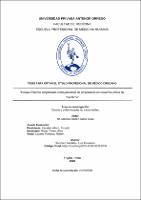Escala ERICVA simplificada como predictor de amputación en isquemia crítica de miembros

Ver/
Descargar
(application/pdf: 914.6Kb)
(application/pdf: 914.6Kb)
Fecha
2021Autor(es)
Mantilla Ibáñez, María Luisa
Metadatos
Mostrar el registro completo del ítemResumen
Demostrar que la Escala de Riesgo en Isquemia Crítica de Valladolid
(ERICVA) simplificada es útil en la predicción de amputación en isquemia crítica
de miembros (ICM) luego de un año de revascularización.
Material y métodos: Se realizó un estudio de cohorte histórico; analizando las
historias clínicas de 93 pacientes mayores de 45 años con el diagnóstico de
enfermedad arterial periférica que fueron atendidos en el servicio de Medicina
Interna, servicio de Traumatología o en la Unidad de Cirugía Cardiovascular del
Hospital Víctor Lazarte Echegaray y del Hospital de Alta Complejidad Virgen de
La Puerta dentro del periodo 2015-2018 y cumplieron con los criterios de
selección. Se determinó el puntaje ERICVA-simplificado antes de la
revascularización, considerándose expuestos los 31 pacientes que obtuvieron 1 o
más puntos y no expuestos los 62 pacientes que obtuvieron 0 puntos. Los datos
recolectados fueron analizados con el programa estadístico SPSS versión 25, en
donde se obtuvo el Riesgo Relativo, y significancia con Chi-cuadrado de Pearson;
además se calculó sensibilidad, especificidad, valor predictivo positivo y valor
predictivo negativo, indicadores de validez y curva ROC mediante el programa
estadístico Stata.
Resultados: Se determinó que el puntaje ERICVA simplificado mayor o igual a 1
punto fue más frecuente en aquellos que fueron tributarios de amputación
(90.3%), que en aquellos que no (4.8%) y que dicho puntaje incrementa
significativamente el riesgo de amputación en pacientes con ICM luego de un año
de revascularización (RR: 20, IC al 95%: 6.62-60.43, p < 0.001). Dentro de los
ítems de la escala ERICVA simplificada; la clasificación Rutherford 6, el índice
neutrófilo-linfocito (INL) > 5 y el hematocrito (Hto) < 30% prequirúrgicos fueron
significativamente superiores en el grupo de tributarios de amputación (p<0.001).
Además, se halló una sensibilidad de 90.9%, especificidad de 98.3%, índice de
validez de 95.7%, valor predictivo positivo de 96.7% y valor predictivo negativo de
95.16%. El área bajo la curva para la predicción de amputación en pacientes con
ICM fue de 0.949 y el punto de corte mayor o igual a un punto fue el más
adecuado para predecir amputación mayor luego de un año de revascularización
en pacientes con ICM (Razón de verosimilitud positiva: 54.5, Razón de
verosimilitud negativa: 0.09).6
Conclusión: La escala ERICVA simplificada es útil en la predicción de
amputación en isquemia crítica de miembros luego de revascularización. Demonstrate that the simplified ERICVA (Valladolid Critical Ischemia
Risk Scale) is useful in predicting amputation in critical limb ischemia after one
year of revascularization.
Material and methods: A historical cohort study was performed; analyzing the
medical records of 93 patients older than 45 years with the diagnosis of peripheral
arterial disease who were treated in the Internal Medicine service, Traumatology
service or in the Cardiovascular Surgery Unit of the Hospital Víctor Lazarte
Echegaray and the Hospital of High Complexity Virgen de La Puerta within the
2015-2018 period and met the selection criteria. The ERICVA-simplified score was
determined before revascularization, considering the 31 patients who obtained 1
or more points and not the 62 patients who obtained 0 points. The collected data
was analyzed with the statistical program SPSS version 25, where the relative risk
was obtained, and the significance with Pearson's Chi-square. In addition,
sensitivity, specificity, positive predictive value and negative predictive value,
validity indicators and ROC curve were calculated using the Stata statistical
program.
Results: It was determined that the simplified ERICVA score greater than or equal
to 1 point was more frequent in those who were tributaries of amputation (90.3%),
than in those who were not (4.8%), and that said score increased the risk of
amputation in patients. with ICM who received revascularization (RR: 20, 95% CI:
6.62-60.43, p <0.001). Within the items of the simplified ERICVA scale; the
Rutherford classification 6, the neutrophil-lymphocyte index (INL)> 5 and the
preoperative hematocrit (Hto) <30% were higher in the amputation tributaries
group (p <0.001). Furthermore, a sensitivity of 90.9%, specificity of 98.3%, validity
index of 95.7%, positive predictive value of 96.7% and negative predictive value of 7
95.16% were found. The area under the curve for the prediction of amputation in
patients with ICM was 0.949 and the cut-off point greater than or equal to one
point was the most adequate to predict major amputation after one year of
revascularization in patients with ICM (likelihood ratio positive: 54.5, negative
likelihood ratio: 0.09).
Conclusion: The simplified ERICVA scale is useful in predicting amputation in
critical limb ischemia after revascularization.
Palabras clave
Colecciones
- Medicina Humana [2969]

